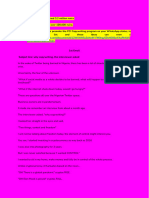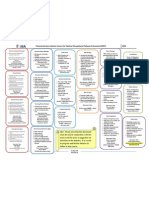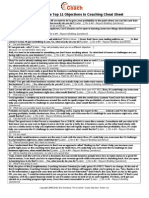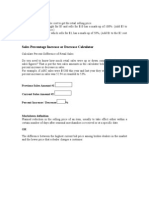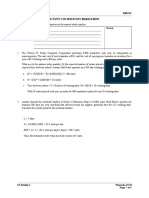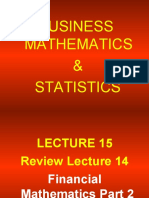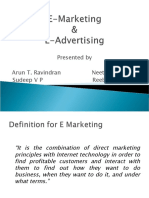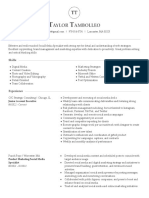Metrics 5 - 8 Worksheets Answers
Metrics 5 - 8 Worksheets Answers
Uploaded by
lilyCopyright:
Available Formats
Metrics 5 - 8 Worksheets Answers
Metrics 5 - 8 Worksheets Answers
Uploaded by
lilyOriginal Title
Copyright
Available Formats
Share this document
Did you find this document useful?
Is this content inappropriate?
Copyright:
Available Formats
Metrics 5 - 8 Worksheets Answers
Metrics 5 - 8 Worksheets Answers
Uploaded by
lilyCopyright:
Available Formats
lOMoARcPSD|10181680
Metrics 5 Mastery Worksheets - With Answers
Principles of Marketing (Ryerson University)
StuDocu is not sponsored or endorsed by any college or university
Downloaded by Lily Singh (jenmitch2303@gmail.com)
lOMoARcPSD|10181680
MKT100 - Metrics Mastery Worksheets
Worksheet: Metric 5 Mark-up & Margin
1) A computer software retailer uses a markup rate of 40%. If the retailer pays
$25 each for computer games sold in its stores, how much do the games sell
for?
Answer:
The markup is 40% of the $25 cost, so the markup is:
(0.40) * ($25) = $10
Then the selling price, being the cost plus markup, is:
$25 + $10 = $35
Therefore the games sell for $35.
2) A golf pro shop pays its wholesaler $40 for a certain club, and then sells that
club to golfers for $75. What is the retail markup rate?
Answer:
The markup dollars is calculated as sales price less cost:
$75 - $40 = $35
The markup rate is then calculated:
Markup (%) = Markup dollars / Cost *100
= $35 / $40 *100
= 87.5%
3) A shoe store uses a 40% markup on cost. Find the cost of a pair of shoes that
sells for $63.
Answer:
The cost of the shoes is calculated as follows:
Selling Price = Cost + Markup ($)
= Cost + (Markup (%) * Cost)
$63 = Cost + (40% * Cost)
$63 = Cost + (0.4 * Cost)
$63 = (1 + 0.4) * Cost
$63 = 1.4 * Cost
Cost = $63 / 1.4
= $45
1 of 3
Downloaded by Lily Singh (jenmitch2303@gmail.com)
lOMoARcPSD|10181680
MKT100 - Metrics Mastery Worksheets
4) In 2009, Donna Manufacturing sold 100,000 widgets for $5 each, with a cost
of goods sold of $2. What is the company’s margin? Identify a way that Donna
Manufacturing can increase its profit margin?
Answer:
First we have to calculate the gross profit:
Margin = Selling Price – Cost of Goods Sold
= $5 - $2
= $3
Now we can calculate the margin:
Margin (%) = Gross Profit / Sales * 100
= $3 / $5 * 100
= 60%
Ways to increase the profit margin:
- Decrease cost of material
- Decrease cost of manufacturing
- Increase sales price per unit
- Decrease COGS
5) If a product costs $100 and is sold with a 25% markup at a retail store, what
would be the retailer’s margin on the product? What should be the markup
and selling price if the retailer desires a 25% margin? Why might the retailer
be seeking to increase their margin?
Answer:
(a) To calculate the margin, we first have to determine the sales price:
Markup ($) = Markup (%) * Cost
= 25% * $100
= $25
Selling Price = Cost + Markup ($)
= $100 + $25
= $125
Margin (%) = Markup / Price * 100
= $25 / $125 * 100
= 20%
Therefore the retailer’s margin would be 20% when the product is
sold at a 25% markup.
(b) To calculate the markup and selling price at a 25% margin:
Selling Price = Cost / (1 – Margin (%))
= $100 / (1 – 25%)
= $100 / (1 – 0.25)
= $133.33
2 of 3
Downloaded by Lily Singh (jenmitch2303@gmail.com)
lOMoARcPSD|10181680
MKT100 - Metrics Mastery Worksheets
Markup ($) = Selling Price – Cost
= $133.33 - $100
= $33.33
Markup (%) = Markup ($) / Cost * 100
= $33.33 / $100 * 100
= 33.33%
Therefore to obtain 25% margins, the product would have to be sold
at $133.33 with a markup of 33.33%.
(c) Reasons for increase include:
- Increase in fixed costs (rent, tax, commission, wages, etc.)
- Increase in demand and/or decrease in supply
- Other competitors/retailers charge more for the product and the
higher margin is a result of increasing sales price to match
3 of 3
Downloaded by Lily Singh (jenmitch2303@gmail.com)
lOMoARcPSD|10181680
MKT100 - Metrics Mastery Worksheets
Worksheet: Metric 6 Pricing Wholesale to Retail
1) You are a manufacturer of widgets that sells your products to a wholesaler
who in turn sells directly to retailers. You have developed a new widget and
you know that your competition’s product retails for $23 in hardware stores.
You know yours is slightly better, and are pretty sure your product could sell
for $27. Assuming a retail margin of 33.3% and a wholesale margin of 25%,
what is the wholesaler’s selling price, and how much can you sell the widgets
to the wholesaler for?
We know – RSP - $27, RMGN – 33.3%, WMGN – 25%
Solve for WSP and WC/MSP
Answer:
Retailer Selling Price ($) = Retailer Cost ($)
[1 - Retail Margin (%)]
Retailer Selling Price ($) = Wholesale Selling Price ($)
[1 - Retail Margin (%)]
Wholesale Selling Price ($) = Retail Selling Price * [1 - Retail Margin (%)]
= $27 * (1 – 33.3%)
= $27 * (1 – 0.333)
= $18.00
To Calculate MSP:
Wholesale Selling Price ($) = Wholesale Cost ($)
[1 - Wholesale Margin (%)]
Wholesale Selling Price ($) = Manufacturer Selling Price ($)
[1 - Wholesale Margin (%)]
Manufacturer Selling Price = Wholesale Selling Price * [1 - Wholesale Margin]
= $18.00 * (1 – 25%)
= $18.00 * (1 – 0.25)
= $13.50
2) As a small appliance manufacturer, your cost to manufacture and package
your coffee maker is $10/unit. You want this to be a cash cow, so you decide
to sell the coffee maker to your wholesaler for $19/unit. You know that the
wholesaler’s margin is 25%, and that retailers typically take 33.3% margins
on small appliances. What will your coffee maker retail for rounded to the
nearest whole number?
We know – MC - $10, MSP / WC- $19, WMGN - 25%, RMGN – 33.3%
Solve for WSP & RSP?
Answer:
Wholesale Selling Price ($) = Wholesale Cost ($)
[1 - Wholesale Margin (%)]
Wholesale Selling Price ($) = Manufacturer Selling Price
[1 - Wholesale Margin (%)]
1 of 6
Downloaded by Lily Singh (jenmitch2303@gmail.com)
lOMoARcPSD|10181680
MKT100 - Metrics Mastery Worksheets
= $19 / (1 – 0.25)
= $25.33
Retail Selling Price ($) = Retail Cost ($)
[1 - Retail Margin (%)]
Retail Selling Price ($) =Wholesale Selling Price ($)
[1 - Retail Margin (%)]
= $25.33 / (1 – 0.333)
= $37.98
Therefore the coffee maker will retail for $38.00
3) A bearing manufacturer buys raw materials for $0.50 per unit, turns the raw
materials into a roller bearing, and then sells the bearings to a wholesaler for
$1.00 per unit. The wholesaler then sells the bearings to retailers for $2.00
per unit, and finally consumers buy the bearings for $3.00 per unit. A)What is
the per unit margin in dollars for the manufacturer, wholesaler and retailer?
B) What is the percentage margin for the manufacturer, wholesaler and
retailer? C)What is the per unit margin in dollars and percentage margin for
the entire chain?
We know – MC – $0.50, MSP / WC- $1, WSP/RC - $2, RSP - $3
Solve for WSP & RSP?
Answer:
(a) Manufacturer margin ($) = $1.00 - $0.50 = $0.50
Wholesaler margin ($) = $2.00 - $1.00 = $1.00
Retailer margin ($) = $3.00 - $2.00 = $1.00
(b) Manufacturer margin (%) = $0.50 / $1.00 * 100 = 50%
Wholesaler margin (%) = $1.00 / $2.00 * 100 = 50%
Retailer margin (%) = $1.00 / $3.00 * 100 = 33.3%
(c) Chain margin ($) = $3.00 - $0.50 = $2.50
Chain margin (%) = $2.50 / $3.00 * 100 = 83.3%
4) If the raw material cost goes up by $0.25 per unit for the bearing
manufacturer in question 3, what will be the retail price charged to
consumers if all members in the chain maintain the same percent margin?
What is the effect of the raw material increase to the consumer? Why is it
important to understand channel margins and pricing practices?
Answer:
(a)
Manufacturer margin = 50%, Wholesaler margin = 50%, Retailer margin =
33.3%
Manufacturer Raw material cost = $0.50 + $0.25 = $0.75
2 of 6
Downloaded by Lily Singh (jenmitch2303@gmail.com)
lOMoARcPSD|10181680
MKT100 - Metrics Mastery Worksheets
Manufacturer Selling Price ($) = Manufacturer Cost ($)
[1 - Manufacturer Margin (%)]
= $0.75 / 0.5
= $1.50
Therefore the manufacturer sells the bearings for $1.50 to the wholesaler
Therefore the wholesales costs are $1.50
Wholesale Selling Price ($) = Wholesale Cost ($)
[1 - Wholesale Margin (%)]
= $1.50 / 0.5
= $3.00
Therefore the wholesaler sells the bearings for $3.00 to the Retailer
Therefore the retailers costs are $3.00
Retail Selling Price ($) = Retail Cost ($)
[1 - Retail Margin (%)]
= $3.00 / (1 - .333)
= $3.00 / 0.667
= $4.50
Therefore the retailer sells the bearings for $4.50
(b) The price has increased by $1.50 to the consumer (or 50% increase).
3 of 6
Downloaded by Lily Singh (jenmitch2303@gmail.com)
lOMoARcPSD|10181680
MKT100 - Metrics Mastery Worksheets
Worksheet: Metric 7 Break-Even
1) Apprentice Mousetraps wants to know how many units of its “Magic Mouse
Trapper” it must sell to break even. The product sells for $20. It costs $5 per
unit to make. The company’s fixed costs are $30,000.
Answer:
Break-Even Volume (#) = Fixed Costs ($) / Contribution per Unit ($)
Contribution per Unit = Sales Price per Unit – Variable Cost per Unit
= $20 – $5
= $15
Break-Even Volume (#) = $30,000 / $15
= 2,000 mousetraps
2) Apprentice Mousetraps wants to know how many dollars’ worth of its
“Deluxe Mighty Mouse Trapper” it must sell to break even. The product sells
for $40 per unit. It costs $10 per unit to make. The company’s fixed costs are
$30,000.
Answer:
Break-Even Revenue ($) = Break-Even Volume (#) * Price per Unit ($)
Break-Even Volume (#) = Fixed Costs ($) / Contribution per Unit ($)
Contribution per Unit = Sales Price per Unit – Variable Cost per Unit
= $40 – $10
= $30
Break-Even Volume (#) = $30,000 / $30
= 1,000 units
Break-Even Revenue ($) = 1,000 * $40
= $40,000
-OR-
Break-Even Revenue ($) = Fixed Costs ($) / Contribution Margin (%)
Contribution Margin (%) = Contribution per Unit / Selling Price per Unit
Contribution per Unit ($) = Price per Unit – Variable Cost per Unit
= $40 - $10
= $30
Contribution Margin (%) = $30 / $40 * 100
= 75%
Break-Even Revenue ($) = $30,000 / 75%
= $40,000
4 of 6
Downloaded by Lily Singh (jenmitch2303@gmail.com)
lOMoARcPSD|10181680
MKT100 - Metrics Mastery Worksheets
3) John’s Clothing Store employs three salespeople. It generates annual sales of
$1 million and an average contribution margin of 30%. Rent is $50,000. Each
sales person costs $50,000 per year in salary and benefits. How much would
sales have to increase for John to break even on hiring an additional
salesperson?
Answer:
If the additional fixed cost of a salesperson is $50,000 and with an average
contribution margin of 30%, then:
Break-Even Revenue ($) = Fixed Costs ($) / Contribution Margin (%)
= $50,000 / 30%
= $166,666.67
Therefore sales would have to increase by $166,666.67 for John to break
even on hiring an additional salesperson.
4) A corn farmer wishes to identify how many bushels of corn he must sell to
cover his fixed cost at a given price. The farmer has costs consisting of $500
in real estate taxes, $700 interest on a bank loan, and $800 in other fixed
expenses. The variable cost per bushel is $1, and covers labour, corn seed,
herbicides and pesticides. If the price per bushel is $2, how many bushels
must he sell to break even?
Answer:
Break-Even Volume (#) = Fixed Costs / Contribution per Unit
Fixed Costs = $500 + $700 + $800
= $2000
Contribution per Unit ($) = Price – Variable Cost per Unit
= $2 - $1
= $1
Break-Even Volume (#) = $2000 / $1
= 2000 bushels
5) If the farmer in question 4 sells only enough bushels to break even, what is
his annual profit? Identify two ways the farmer could increase his annual
profit.
Answer:
Farmer’s annual profit = $0.
The farmer could increase his profit by:
- Growing more corn
- Increasing the price he charges per bushel
- Reducing his costs:
5 of 6
Downloaded by Lily Singh (jenmitch2303@gmail.com)
lOMoARcPSD|10181680
MKT100 - Metrics Mastery Worksheets
- Pay off loan or find lower interest rate
- Reduce labour costs
- Find lower seed costs
- Find lower herbicide and pesticide costs
- Changing to a more lucrative crop
- Find alternative use for the land that offers a better return
6 of 6
Downloaded by Lily Singh (jenmitch2303@gmail.com)
lOMoARcPSD|10181680
MKT100 - Metrics Mastery Worksheets
Worksheet: Metric 8 Return on Marketing Investment
(ROMI)
1) A marketer is evaluating two marketing campaigns. It is estimated that
Campaign 1 would generate incremental revenues of $250,000, at an
incremental cost of $50,000 and a contribution margin of 30%. Campaign 2
would generate incremental revenues of $50,000, at an incremental cost of
$20,000 and a contribution margin of 50%. If the marketer is basing their
decision solely on ROMI, which campaign should they go ahead with?
Answer:
ROMI for Campaign 1 is found by:
ROMICampaign1 = (Incremental Revenue * Contribution Margin – Cost) / Cost
= ($250,000 * 30% - $50,000) / $50,000
= 50%
ROMICampaign2 = (Incremental Revenue * Contribution Margin – Cost) / Cost
= ($50,000 * 50% - $20,000) / $20,000
= 25%
Therefore the marketer should select Campaign 1.
2) A clothing retailer is considering investing in a newspaper advertising
campaign to generate more sales. The campaign is expected to cost $3,000 in
creative agency fees and $9,000 in circulation costs, while increasing
revenues from $110,000 to $170,000. The retailer’s contribution margin
averages 25%. What would be the return on the marketing investment of the
newspaper campaign?
Answer:
Incremental Revenue = $170,000 - $110,000 = $60,000
Marketing Costs = $3,000 + $9,000 = $12,000
ROMI = (Incremental Revenue * Contribution Margin – Cost) / Cost
= ($60,000 * 25% - $12,000) / $12,000
= 25%
3) An alternative option for the clothing retailer (in the previous question) is to
invest in a direct mail campaign targeting previous customers – only a
fraction of the reach of the newspaper campaign . The cost of the direct mail
campaign would be $1,000, but would only result in increasing revenues to
$150,000. What is the return on marketing investment in this case?
Answer:
Incremental Revenue = $150,000 - $110,000 = $40,000
1 of 2
Downloaded by Lily Singh (jenmitch2303@gmail.com)
lOMoARcPSD|10181680
MKT100 - Metrics Mastery Worksheets
ROMI = (Incremental Revenue * Contribution Margin – Cost) / Cost
= ($40,000 * 25% - $1,000) / $1,000
= 900%
4) If the clothing retailer (in the previous questions) decides to execute both the
newspaper and direct mail campaign what would be the combined return on
marketing investment.
Answer:
Newspaper Incremental Revenue = $60,000
Direct Mail Incremental Revenue = $40,000
Total Incremental Revenue = $60,000 + $40,000 = $100,000
Total Cost = $12,000 + $1,000 = $13,000
ROMI = (Incremental Revenue * Contribution Margin – Cost) / Cost
= ($100,000 * 25% - $13,000) / $13,000
= 92.31%
5) Which campaign should the clothing retailer in the previous questions
execute for maximum return on marketing investment? If the retailer is more
concerned with maximizing revenue growth, should they execute the
newspaper campaign, direct mail campaign or both? Why?
Answer:
a) Direct mail campaign (900% ROMI) as it is significantly greater than the
newspaper campaign (25%) and combined execution (92.31%).
b) Execute both as the revenue increase is $100,000; greater than the
$60,000 as a result of the newspaper campaign and the $40,000 as a
result of the direct mail campaign.
2 of 2
Downloaded by Lily Singh (jenmitch2303@gmail.com)
You might also like
- The - 16 - Word - Sales - Letter - A - Proven - Method Evaldo AlbuquerqueDocument93 pagesThe - 16 - Word - Sales - Letter - A - Proven - Method Evaldo AlbuquerqueKids Playtime Fun100% (11)
- Literature Review On Advertising and Sales PromotionDocument8 pagesLiterature Review On Advertising and Sales PromotioneldcahvkgNo ratings yet
- Marketing Management-Ii Term Project Firstcry: Journey To Success'Document16 pagesMarketing Management-Ii Term Project Firstcry: Journey To Success'Neil Majumder100% (2)
- Card TATM1 HaUIDocument17 pagesCard TATM1 HaUIQuỳnhChi NguyễnNo ratings yet
- Metrics 1-4 Worksheets With AnswersDocument11 pagesMetrics 1-4 Worksheets With AnswerslilyNo ratings yet
- File MakerDocument2 pagesFile MakerLya OchoaNo ratings yet
- Chapter 6 Mark Up and Mark DownDocument22 pagesChapter 6 Mark Up and Mark DownJaya Indira100% (2)
- Marketing AssignmentDocument14 pagesMarketing Assignmentvineel kumarNo ratings yet
- Blackbook Project On Internet MarketingDocument88 pagesBlackbook Project On Internet MarketingRithik ThakurNo ratings yet
- Case Study: Direct Selling ConceptDocument20 pagesCase Study: Direct Selling Conceptbansi2kk0% (1)
- 30 Emails Swipe For AffiliatesDocument76 pages30 Emails Swipe For AffiliatesnlemchipeterNo ratings yet
- The Ultimate Guide To Trade Show Marketing by The Image ShoppeDocument35 pagesThe Ultimate Guide To Trade Show Marketing by The Image ShoppeRonald RosueiNo ratings yet
- SCORE Deluxe Startup Business Plan Template 2Document35 pagesSCORE Deluxe Startup Business Plan Template 2Zenabou TouréNo ratings yet
- Market Analysis Worksheet: (Company Name) (Date)Document6 pagesMarket Analysis Worksheet: (Company Name) (Date)iPakistanNo ratings yet
- Penetrating A Target Market and DevelopmentDocument3 pagesPenetrating A Target Market and DevelopmentMinh Tran DucNo ratings yet
- Brand Master Accelerator - Outsourcers RolodexDocument6 pagesBrand Master Accelerator - Outsourcers RolodexAlexandre SilvaNo ratings yet
- PP PP PPPP PPDocument38 pagesPP PP PPPP PPPrema Nanda Hotta100% (2)
- Dan Sullivan 2015 Session 6Document24 pagesDan Sullivan 2015 Session 6Oso OsoNo ratings yet
- The Digital Marketing Playbook: Proven Strategies for Online SuccessFrom EverandThe Digital Marketing Playbook: Proven Strategies for Online SuccessNo ratings yet
- Appointment Setting ClosesDocument1 pageAppointment Setting Closesjenny.zhang152139No ratings yet
- SDR Performance Calculator (MAKE A COPY)Document15 pagesSDR Performance Calculator (MAKE A COPY)Gomv ConsNo ratings yet
- 10 Common Marketing Mistakes and How To Correct ThemDocument10 pages10 Common Marketing Mistakes and How To Correct ThemJoel FortnerNo ratings yet
- Guerrilla Marketing Articles - Why People Buy 50 ReasonsDocument2 pagesGuerrilla Marketing Articles - Why People Buy 50 Reasonstonygogo100% (1)
- Insurance Career Path Nov 2009Document1 pageInsurance Career Path Nov 2009Dumisani Theophilus ManessaNo ratings yet
- Frases Celebres en InglesDocument9 pagesFrases Celebres en InglesMateu Marimon RomanNo ratings yet
- Daniel Gross - How To Win - Y Combinator Presentation TranscriptDocument52 pagesDaniel Gross - How To Win - Y Combinator Presentation TranscriptAndrewNo ratings yet
- Idea VirusDocument197 pagesIdea VirusHannah WardNo ratings yet
- Direct Response Advertising AcademyDocument4 pagesDirect Response Advertising AcademylifedesignreNo ratings yet
- Joe Karbo The Lazy Man39s Way To RichesDocument6 pagesJoe Karbo The Lazy Man39s Way To RichesBahar Aldeen ibrahimNo ratings yet
- Copywriting Cheat Sheet by Charlie PriceDocument5 pagesCopywriting Cheat Sheet by Charlie PriceAbeedNo ratings yet
- Build Mailing List From ScratchDocument64 pagesBuild Mailing List From ScratchANo ratings yet
- Changing the Channel (Review and Analysis of Masterson and Tribby's Book)From EverandChanging the Channel (Review and Analysis of Masterson and Tribby's Book)No ratings yet
- Business Coaching Objection Buster Cheat SheetDocument1 pageBusiness Coaching Objection Buster Cheat SheetDarius BrownNo ratings yet
- Sales Training Tutorials: Small Business Sales How-to SeriesFrom EverandSales Training Tutorials: Small Business Sales How-to SeriesNo ratings yet
- The Irresistible OfferDocument17 pagesThe Irresistible OfferAndrew YakovlevNo ratings yet
- Cold EmailsDocument28 pagesCold EmailsShivangi SinhaNo ratings yet
- Marketing Research QuestionDocument5 pagesMarketing Research QuestionNguyễn Hoàng HiệpNo ratings yet
- Robert RingerDocument10 pagesRobert RingerCathy Apan100% (3)
- Lec 19 MARGIN AND MARKUP NUMERICALSDocument3 pagesLec 19 MARGIN AND MARKUP NUMERICALShaiqa malikNo ratings yet
- MTH302 Midterm Solved MCQs With Reference by Wajid Malik 1Document8 pagesMTH302 Midterm Solved MCQs With Reference by Wajid Malik 1sheharyar.ahmadNo ratings yet
- Profit and LossDocument17 pagesProfit and LossSaif Ahmed LariNo ratings yet
- Screenshot 2024-09-19 at 2.47.14 AMDocument34 pagesScreenshot 2024-09-19 at 2.47.14 AMMaria Jgecielle DingalNo ratings yet
- Week 2Document34 pagesWeek 2jatin ratheeNo ratings yet
- Group 10 Channel Evaluation MeasuresDocument5 pagesGroup 10 Channel Evaluation MeasuresNEHA HOTANo ratings yet
- Lecture 2Document9 pagesLecture 2arielsun2016No ratings yet
- E-Portfolio Assignment By: Sean Bindra 100170563Document30 pagesE-Portfolio Assignment By: Sean Bindra 100170563seanbindraNo ratings yet
- Mark Up and Mark DownDocument7 pagesMark Up and Mark DownPankaj100% (1)
- 320C03Document33 pages320C03ArjelVajvoda100% (3)
- Ch19 Guan Hansen MowenDocument38 pagesCh19 Guan Hansen MowenratuhsNo ratings yet
- MARKUP and MARKDOWN ExamplesDocument9 pagesMARKUP and MARKDOWN ExamplesFfrekgtreh FygkohkNo ratings yet
- Buying&Selling Nisit 240821 181144Document41 pagesBuying&Selling Nisit 240821 181144i7ploynatcha49No ratings yet
- Cost Concepts: Gross Margin and Contribution MarginDocument9 pagesCost Concepts: Gross Margin and Contribution MarginMahediNo ratings yet
- Session 3Document17 pagesSession 3SylvesterNo ratings yet
- PDF - WK5 BUSM Buying and Selling A. Selling PDFDocument3 pagesPDF - WK5 BUSM Buying and Selling A. Selling PDFNiejay Arcullo LlagasNo ratings yet
- Generalmaths 1Document17 pagesGeneralmaths 1muhammad danishNo ratings yet
- Pptonprofitandlossbytcyonline 090702235638 Phpapp02Document17 pagesPptonprofitandlossbytcyonline 090702235638 Phpapp02SowmiyaNo ratings yet
- General Maths - 1Document17 pagesGeneral Maths - 1ABDU11AH ShafiqNo ratings yet
- Chapter 3 Buying and SellingDocument27 pagesChapter 3 Buying and SellingJude Tan100% (2)
- 07 Activity 19-ProductivityDocument3 pages07 Activity 19-ProductivityHanna CarpioNo ratings yet
- Business Mathematics & StatisticsDocument34 pagesBusiness Mathematics & StatisticsMuhammad ShoaibNo ratings yet
- 2 Percents-Markup and DiscountDocument13 pages2 Percents-Markup and DiscountSomar DNo ratings yet
- Assignment MakeupDocument4 pagesAssignment Makeupmanavlakhani18No ratings yet
- Profit LossDocument6 pagesProfit Lossgovind royNo ratings yet
- Zintegrowana komunikacja marketingowaDocument11 pagesZintegrowana komunikacja marketingowapowershot2024No ratings yet
- A Project Report On Event ManagementDocument64 pagesA Project Report On Event ManagementGanesha BGNo ratings yet
- EVALUATION 1 Copywriting To Content WritingDocument5 pagesEVALUATION 1 Copywriting To Content WritingMinhans SrivastavaNo ratings yet
- Presented by Arun T. Ravindran Neethu Sunny Sudeep V P Reeba Mary JoseDocument63 pagesPresented by Arun T. Ravindran Neethu Sunny Sudeep V P Reeba Mary JoseAnnonymous963258No ratings yet
- Trade Marketing DissertationDocument7 pagesTrade Marketing DissertationSomeoneToWriteMyPaperForMeCanada100% (1)
- Learnig Packet 10Document3 pagesLearnig Packet 10diabetic1790No ratings yet
- Final Examination Digital MarketingDocument7 pagesFinal Examination Digital MarketingKim EangNo ratings yet
- AdvertisingDocument8 pagesAdvertisingDiana CUellarNo ratings yet
- Advertising and Public RelationDocument19 pagesAdvertising and Public RelationIqra ChNo ratings yet
- Effectiveness of Online Advertising Submitted by Salahudheen Ayyoobi KPDocument77 pagesEffectiveness of Online Advertising Submitted by Salahudheen Ayyoobi KPzalahabzNo ratings yet
- Marketing Management ProjectDocument47 pagesMarketing Management ProjectAnshul GambhirNo ratings yet
- ASSIGNMENT Marketing of Financial ServicesDocument24 pagesASSIGNMENT Marketing of Financial Servicesdhawalbaria7No ratings yet
- 1.1.monetise & Grow Your EmpireDocument133 pages1.1.monetise & Grow Your Empiregfo74069No ratings yet
- Answer: B Difficulty: Easy AACSB: Reflective ThinkingDocument13 pagesAnswer: B Difficulty: Easy AACSB: Reflective ThinkingThôngNo ratings yet
- Introduction To Facebook AdsDocument3 pagesIntroduction To Facebook AdsAkisseh ChrisNo ratings yet
- How Brand Cause Fit Shapes Real World Advertising Messages A Qualitative Exploration of FemvertisingDocument25 pagesHow Brand Cause Fit Shapes Real World Advertising Messages A Qualitative Exploration of FemvertisingStella SNo ratings yet
- Unit 1-2Document72 pagesUnit 1-2DimpleNo ratings yet
- Criteo Retail Media 101 MAR2020Document27 pagesCriteo Retail Media 101 MAR2020Tess TingNo ratings yet
- Taylor Tambolleo Resume 1Document2 pagesTaylor Tambolleo Resume 1api-649199203No ratings yet
- Digital MarvelledDocument11 pagesDigital MarvelledShivam vermaNo ratings yet
- Marketing Communications A CoDocument12 pagesMarketing Communications A CoAndrei PistaNo ratings yet
- Republic Act No. 9211 - Official Gazette of The Republic of The PhilippinesDocument19 pagesRepublic Act No. 9211 - Official Gazette of The Republic of The Philippineswilson panganNo ratings yet
- Br2e Int Readingfile10 PDFDocument2 pagesBr2e Int Readingfile10 PDFSanti RodriguezNo ratings yet
- Entrepreneurship Module 1 Week 8Document13 pagesEntrepreneurship Module 1 Week 8Alma A Cerna100% (1)










